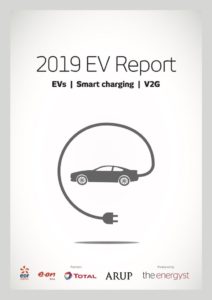
Mitie has ambitious plans to convert its fleet to electric vehicles. But getting hold of the vehicles is no mean feat.
Mitie plans to switch 20 per cent of its cars and small vans to EVs by 2020. That’s around 717 vehicles, says fleet and procurement director, Simon King.
“It’s very important to focus on the fleet, because it makes up 93 per cent of Mitie’s carbon footprint,” says King. “That initial tranche of EVs will save over 4,000 tonnes of CO2 per annum – about the same as planting 200,000 trees.”
Switching 700 vehicles is ambitious. King sweated on his presentation to CEO Phil Bentley, but says he needn’t have worried.
“Selling sustainability ideas into a business can be something of a challenge. I spent the weekend preparing a great presentation, but Phil said ‘you don’t need to persuade me, it’s a great idea’.”
Roadblocks
King believes issues of cost and range “have largely been addressed”, at least for small vans and cars, and that Mitie can make the switch cost neutral with upfront cost mitigated by fuel savings.
The roadblocks that remain, says King, are charging points and driver behaviour.
“Zap-Map shows about 19,000 plug-in sockets in the UK, so we need to have the right charging points in place.” These will be installed at employees’ homes as well as Mitie offices and the company is also approaching customers with a view to installing them at suitable sites.
“We will be deploying 800 chargers by the end of 2020,” says King. “That’s about the same amount as have been installed in the UK in the last three months.”
Driver behaviour
King says battery-powered cars require a shift in driver behaviour – topping up batteries more regularly instead of filling up only when the fuel light flickers.
The company is developing learning programmes for drivers to support safety and charging behaviour, but King thinks Mitie drivers have appetite for disruption. To gauge staff receptiveness, the firm emailed a survey to 1,200 drivers for whom an EV may be suitable. “Within three days we had over 500 responses, which shows a real willingness from employees,” says King.
Vehicles
Vehicle supply is a challenge. “My biggest ask of car and van manufacturers is: meet with us, commit to supply and provide visibility on what they can deliver through to the end of 2020,” says King. “We need partnerships and commitments.”
With hindsight, he says Mitie would have engaged manufacturers even earlier to secure guarantees.
“We are used to buying 1,500 vehicles a year and having a fairly robust supply chain,” says King. “Buying smaller numbers with different suppliers presents a different challenge. But vehicles ultimately spread to the wider market through fleets via the secondary market – so engaging will help us all do the right thing by the planet.”
With current visibility, Mitie is attempting to match the rollout of chargers with incoming vehicles.
“There is an element of chicken and egg, but we are trying to address both parts. With our experience of managing professional services, we think we are ideally suited to manage that piece of work,” says King.
Applying the insight from the project will also provide a commercial advantage as Mitie starts to manage EV rollouts for customers.
Billing and benefits
Working out how to recompense employees is not straightforward, says King.
“Electricity is not classed as fuel in the same way that diesel and petrol is, so there are some unique challenges in terms of recompense – and we know some other large fleets are struggling in exactly the same way.”
Mitie will use technology to track how much electricity each EV uses to ensure employees with home chargers are fairly reimbursed. “But it is one of the biggest challenges,” admits King.
“I believe we have a workable solution, but I would like to see a situation where companies can pay directly for electricity being used at employees homes to charge EVs.”
He says “utopia” would be a corporate renewable power contract that could extend to employee’s home charging use, with all billing direct to Mitie. While “the regulation is not quite there” to support such an approach, Mitie is “interested in speaking with people that can support that aim”, says King.
Chargers and capacity
Mitie aims to deploy 7.2kW chargers at homes and workplaces – which will be smart where possible, says King. At sites where a large number of chargers will be installed, they will be “linked together to do load balancing”, avoiding the cost of additional capacity, says King.
Mitie is also open to collaboration with other large fleets to access semi-public and rapid chargers, which will become increasingly useful as Mitie looks beyond small vans and cars.
However, that may take some time to eventuate.
“We have lots of transit sized vehicles, but [electric versions] are just not available,” says King. The low volumes that are available don’t cut it.
“Paying a high price for a 45-mile range in winter is not commercially viable,” he says.
“If you know a manufacturer with a solution, give them my mobile number.”
 A version of this article was first published in The Energyst’s 2019 EV Report, available as a free download.
A version of this article was first published in The Energyst’s 2019 EV Report, available as a free download.
The report includes a survey of industrial, commercial and public sector organisations on EV and charging rollout plans, including their attitudes towards smart charging and vehicle-to-grid. It also contains interviews with businesses installing charging infrastructure, including Marston’s, Mitie, SES Water and UPS. There are also views from charge point operators, technology providers, consultants and technology companies, as well as energy companies.
Download the report here.
Related stories:
SES Water starts electric van trial with eye on vehicle-to-grid
Vehicle-to-grid: Are we nearly there yet?
EVs: How UPS is driving down emissions
Oxford goes large on EVs, hybrid storage and heat pumps
Superchargers: Why the chicken crossed the road
WPD outlines EV numbers it can handle, connections and upgrade costs
EVs: Car parks sought for V2G trials
Nissan: 2019 will be “breakthrough year” for V2G, eyes energy retail market
Volkswagen: Carmaker to become energy company
Pubs and supermarkets the new petrol stations?
Chargepoint raises £189m to fund EV charging infrastructure
BT and Eon pledge to electrify fleet by 2030
Total partners with Chargepoint to bundle energy and EVs to businesses
Octopus backs flex and EVs for growth
Energy managers to become fleet managers
EV boom no sweat, says National Grid
Flexitricity chief: UK has enough spare power electrify every car on the road
Pivot makes huge play for 2GW storage and EV charging network
‘Land grab’ for EV car parks and revenue
National Grid predicts huge solar growth, while EVs create huge storage capacity
Follow us at @EnergystMedia. For regular bulletins, sign up for the free newsletter.




Mitie should think about hydrogen-electric cars (FCEVs) in their strategy which would give their vehicles a much longer range and fast fill up times, which will save employee time and not have the problem of the limited life of lithium batteries. The hydrogen can be produced off-peak from the grid or renewables where it is dispensed as is done in Germany.